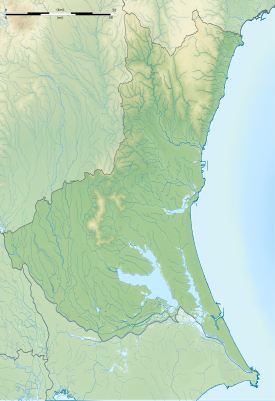Tsuchiura Castle
| Tsuchiura Castle | ||
|---|---|---|
|
Tsuchiura Castle, Drum Gate |
||
| Creation time : | 15th century | |
| Castle type : | Hirajiro (Lower Castle) | |
| Conservation status: | Partly preserved | |
| Place: | Tsuchiura | |
| Geographical location | 36 ° 5 '6.4 " N , 140 ° 11' 53.3" E | |
|
|
||
The Tsuchiura Castle ( Japanese 土 浦城 , Tsuchiura-jō ) is located in the city of Tsuchiura in Ibaraki Prefecture . In the Edo period , the Tsuchiya last resided there as a larger Fudai daimyo .
Lords of the castle in the Edo period
- From 1601 the Fujii Matsudaira with 35,000 Koku ,
- from 1618 the Nishio with 20,000 Koku,
- from 1649 the Kutsuki with 30,000 Koku,
- from 1669 the Tsuchiya with 45,000 Koku,
- from 1682 a branch of Ōkōchi with 22,000 koku,
- from 1687 again the Tsuchiya with 65,000 Koku.
history
In the Eikyō period (1429 to 1441) Imaizumi Saburō, a vassal of the Oda , is said to have built a castle in Tsuchiura. Sugenoya Katsusada ( 菅 谷 勝 貞 ), also a vassal of the Oda, is said to have resided there in the Sengoku period . He fell during the siege of Odawara in 1590.
When Tokugawa Ieyasu took over the Kanto area, Tsuchiura came to his second son, Yūki Hideyasu ( 結城秀康 ; 1574-1607), who, however, after the Battle of Sekigahara in the province of Echizen was added. The Fujii-Matsudaira and other daimyo followed as lords of the castle, until finally the Tsuchiya took over the castle again and stayed there for almost 200 years until 1868.
The attachment
Tsuchiura Castle used the Sakuragawa River ( 桜 川 ) and its tributaries, as well as wetlands north of Lake Kasumigaura . It was a low castle protected by a fivefold moat system. And since it had the shape of a turtle emerging from the sea, it was also called "Turtle Castle" ( 亀 城 , Kijō ).
Around the central area, the Hommaru ( 本 丸 ; 1), the second and third castle areas, the Ni-mo-maru ( 二 ノ 丸 ; 2) and the San-no-maru ( 三 ノ 丸 ; 3) and other areas were created. The rivers, marshes, Kaminuma ( 上 沼 ; K) and Shimonuma ( 下 沼 ; S) were cleverly used, so that one can speak of a moated castle. To the south led through the main gate ( ō 手 門 , Ōte-mon ; H) the Edo-kaidō ( 江 戸 街道 ) to Edo , to the north from the gate [M] the Mito-kaidō ( 水 戸 街道 ) to Mito .
At the beginning of the Meiji period , the residence in Hommaru was still preserved, but it was lost in 1884, together with the east watchtower ( 東 櫓 , Higashi-yagura ). Today the former Hommaru and Ni-no-maru is a public park called Kijō-Kōen ( 亀 城 公園 ). In 1952 the remains of the castle complex with the drum gate ( 太 鼓 櫓 門 , Taiko-yaguramon ; A) were registered as traces of the history of the prefecture. In 1980 the Kōrai Gate ( 高麗 門 , -mon ; C) was restored. There is also the Kasumi gate ( 霞 門 , -mon ; B), moats and remains of the ramparts. In 1991 the east watchtower and in 1998 the west watchtower (西 櫓, Nishi-yagura ) - both marked in orange - were restored. In the Hommaru there is a shrine in honor of the Tsuchiya princely family, on the western edge the city museum ( 土 浦 市立 博物館 , Tsuchiura shiritsu hakubutsukan ; M).
literature
- Sugai, Yasuo: Tsuchiura-jo in: Miura, Masayuki (Ed.): Shiro to jinya. Tokoku-hen. Gakken, 2006. ISBN 978-4-05-604378-5 , p. 100.
- Nishigaya, Yasuhiro (Ed.): Tsuchiura-jo. In: Nihon meijo zukan, Rikogaku-sha, 1993. ISBN 4-8445-3017-8 .




